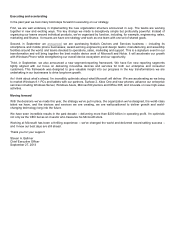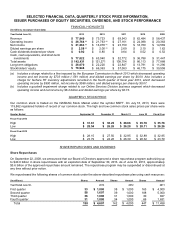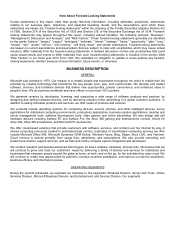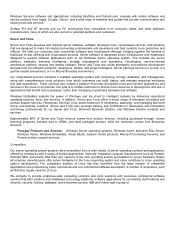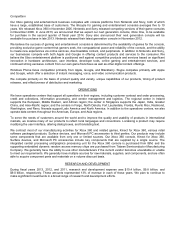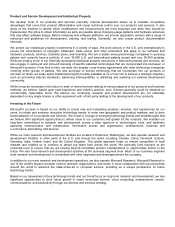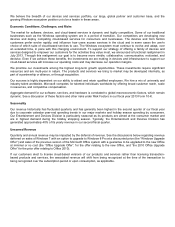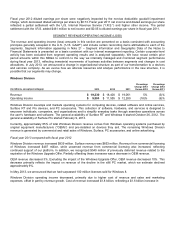Microsoft 2013 Annual Report Download - page 11
Download and view the complete annual report
Please find page 11 of the 2013 Microsoft annual report below. You can navigate through the pages in the report by either clicking on the pages listed below, or by using the keyword search tool below to find specific information within the annual report.team, and organization productivity through a range of programs, services, and software solutions and generates over
90% of MBD revenue. Growth in Office depends on our ability to add value to the core Office product set and to continue
to expand our product offerings in other areas such as content management, enterprise search, collaboration, unified
communications, and business intelligence. Microsoft Dynamics products provide business solutions for financial
management, customer relationship management (“CRM”), supply chain management, and analytics applications for
small and mid-size businesses, large organizations, and divisions of global enterprises.
Approximately 85% of MBD revenue is generated from sales to businesses, which includes Office revenue generated
through subscriptions and volume licensing agreements as well as Microsoft Dynamics revenue. Revenue from sales to
businesses generally depends upon the number of information workers in a licensed enterprise and is therefore relatively
independent of the number of PCs sold in a given year. Approximately 15% of MBD revenue is derived from sales to
consumers, which includes revenue from retail packaged product, subscription sales, and OEM revenue. This revenue
generally is affected by the level of PC shipments, the shift to subscription-based licensing, and product launches.
Principal Products and Services: Microsoft Office; Microsoft Exchange; Microsoft SharePoint; Microsoft Lync;
Yammer; Microsoft Office Project and Office Visio; Microsoft Dynamics ERP and Dynamics CRM; Microsoft Office
365, which is an online services offering of Microsoft Office, Exchange, SharePoint, Lync, and Microsoft Office Web
Apps, which are the online companions to Microsoft Word, Excel, PowerPoint, and OneNote.
The general availability of the new Office started on January 29, 2013.
Competition
Competitors to Office include software application vendors such as Adobe, Apple, Cisco, Google, IBM, Oracle, SAP, and
numerous Web-based competitors as well as local application developers in Asia and Europe. Apple distributes versions
of its application software products with various models of its PCs and through its mobile devices and has a measurable
installed base for these pre-installed applications, such as email, note taking, and calendar. Cisco is using its position in
enterprise communications equipment to grow its unified communications business. IBM has a measurable installed base
with its office productivity products. Google provides a hosted messaging and productivity suite that competes with Office.
Web-based offerings competing with individual applications can also position themselves as alternatives to Office
products. We believe our products compete effectively based on our strategy of providing powerful, flexible, secure, easy
to use solutions that work well with technologies our customers already have and are available on a device or via the
cloud.
Our Microsoft Dynamics products compete with vendors such as Oracle and SAP in the market for large organizations
and divisions of global enterprises. In the market focused on providing solutions for small and mid-sized businesses, our
Microsoft Dynamics products compete with vendors such as Infor, Sage, and NetSuite. Salesforce.com’s on-demand
CRM offerings compete directly with Microsoft Dynamics CRM Online and Microsoft Dynamics CRM’s on-premise
offerings.
Entertainment and Devices Division
Entertainment and Devices Division (“EDD”) develops and markets products and services designed to entertain and
connect people. The Xbox entertainment platform, including Kinect, is designed to provide a unique variety of
entertainment choices through the use of our devices, peripherals, content, and online services. Skype is designed to
connect friends, family, clients, and colleagues through a variety of devices. Windows Phone is designed to bring users
closer to the people, applications, and content they need, while providing unique capabilities such as Microsoft Office and
Xbox LIVE. Through a strategic alliance, Windows Phone and Nokia are jointly creating new mobile products and services
and extending established product and services to new markets. EDD revenue also includes revenue from licensing
mobile-related patents.
Principal Products and Services: Xbox 360 gaming and entertainment console, Kinect for Xbox 360, Xbox 360
video games, Xbox 360 accessories; Xbox LIVE; Skype; and Windows Phone.



